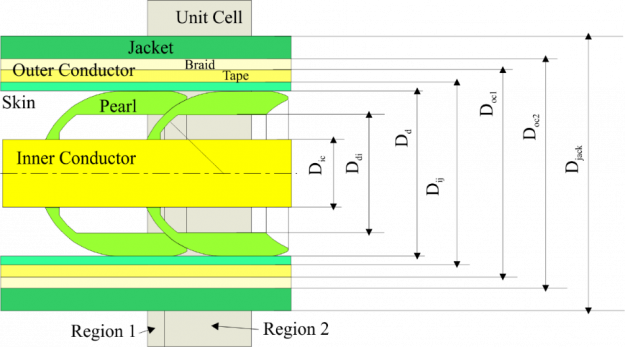-
StatusCompleted
-
Status date2016-04-12
This activity has focused on the development of ultra-light RF cables capable to handle RF power signals as considered for future telecom payloads. State of the art RF power cables have a serious limitation imposed by the poor thermal conductance from the inner conductor to the outside of the cable. This also implies poor phase stability which is an important requirement when combining amplifiers in reconfigurable or extremely high power payloads.
The objective of this activity was the development of a coaxial cable for Multiport Amplifier power combining application in satellites, i.e.
Design, fabrication and characterisation of a coaxial cable with
- Lowest possible mass
- Extreme phase stability
- Sufficient power handling performance
- Good PIM performance

Schematic of the cross section of the phase stable cable.
The major challenges of this activity were the reduction of the cable mass in the order of 30-40% and also to meet the stringent requirements on phase stability. The remaining RF parameters, however, should not significantly be degraded.
To achieve these ambitious goals, first suitable models for the phase stability behaviour of a cable had to be developed, especially the extremely important dependence of the relative permittivity of the dielectric material on temperature and mechanical stresses. A suitable set of materials had to be found for the final design of the phase-stable cable.
One of the early results of the project was that it is impossible to design a space-grade cable with optimum power-handling and low-loss performance on the one side and high phase-stability on the other side. The achieved cable design provides an excellent compromise of these parameters with emphasis on phase stability and cable mass. For all cables in the market with equivalent mass it shows the best phase stability. Or, on the other side, for all cables with equivalent phase stability it has least mass.
The cable assemblies show a relative phase change with temperature of <1000 ppm for temperatures between -55°C to 165°C in the full frequency range up to 18 GHz and <500 ppm for temperatures between -55°C and 125°C for frequencies up to 2 GHz (<440 ppm). At 3 GHz we see a value of 540 ppm. The phase difference increases with frequency. However, at 18 GHz we still have a low value of 730 ppm. The total mass per length of the cable is 47.99 g/m.
The project was split into two phases: Phase 1 with a literature and experience survey, an extensive study phase, and a first design and preliminary test plan. Phase 2 with the hardware fabrication, the extensive testing of the cables and cable-assemblies, followed by the discussion of the achieved performance and results. The cable performance has been compared to state-of-the-art cables. Possible improvements have been identified.
The project has been completed from Feasibility Study to Demo.
PROJECT MANAGERS
Holger Karstensen, Michael Mattes, Gerald Kress


